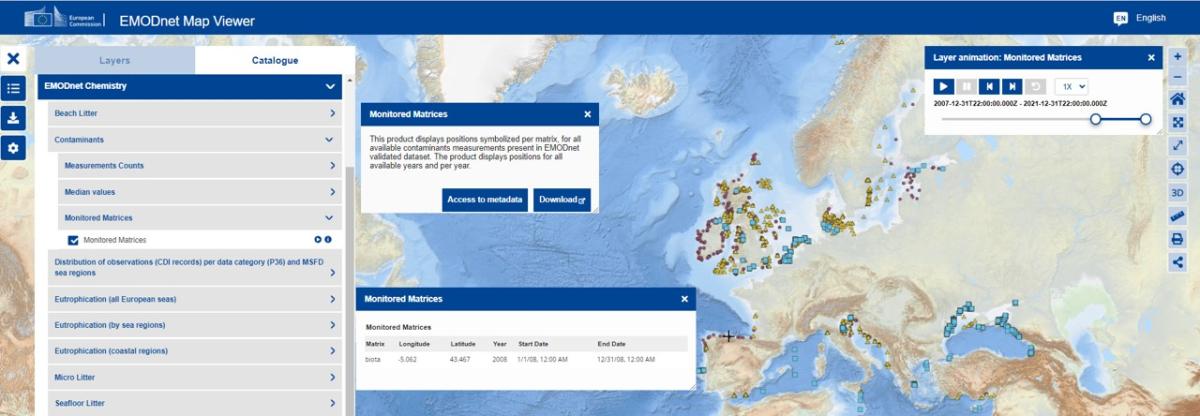EMODnet Chemistry have produced new maps for different hazardous substances in the categories heavy metals, pesticides, hydrocarbons, and polychlorinated biphenyls (PCBs). Specifically, the maps were produced by the Hellenic Centre for Marine Research (HCMR) for the following 12 parameters of Marine Strategy Framework Directive (MSFD) interest for seawater, sediment, and biota: DDT-DDE-DDD, Hexachlorobenzene, Tributyltin, Triphenyltin, Mercury, Cadmium, Lead, Nickel, Anthracene, Fluoranthene, Benzo(A)Pyrene, and Naphthalene.
The maps display the spatial distributions of sampling stations and data availability over the years without any interpretation of data values. The map types are: 1) Monitored matrices showing stations per matrix including animation per year, 2) Per parameter showing stations for each parameter above per matrix with value counts and animation per year and attribute tables, 3) Per parameter, coloured median values for the last 6 years, per matrix, using percentile median ranges, 4) Biota maps per parameter showing stations with percentages of all available data values per animal group for all years. The first three types have already been published on the EMODnet Map Viewer. Full information can be found on the EMODnet Products Catalogue.
The map products are based on aggregated, harmonised and validated datasets for each European sea basin. The regional data collections were produced by the EMODnet Chemistry partnership in 2023 and include common documented quality control (QC) procedures. The large heterogeneity of data on hazardous substances, including filter size, size classes, QC flagging scales, units Limits of Quantification/Detection (LOQ/LOD), was the main challenge in creating a unique dataset with over 138 000 items and more than 3 million values covering a period from 1960 to 2022.
The maps were presented to the MSFD Board of Experts for hazardous substances from all over Europe and were favourably received. At this board meeting, the process for creating the datasets, including the quality control steps for the latest hazardous substance datasets and map products, was presented.
During the meeting, EMODnet Chemistry explained to experts that the main purpose is making data widely available, using good standards and encouraging best use of this data. We have been working towards making everything transparent, collecting important metadata and ensuring the quality of the information. Indeed, the experts stated that quality control procedures, together with maximising the number of data points, i.e. measurements, are the most important aspect of working with hazardous substances.
Discover the maps on the EMODnet Map Viewer and find more information in the Products Catalogue.

The map displaying the monitored matrices. As with the previous maps, once you have selected the layer, you can 1. access the metadata and download the map by clicking on the information (i), and 2. view the animation showing the measurements per matrix over the years. If you click on a measurement point, you can see the reference metadata. (©EMODnet Chemistry)
